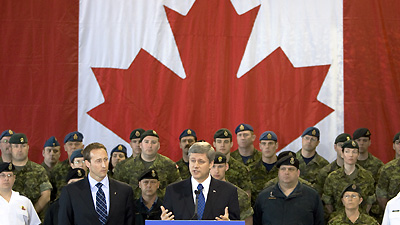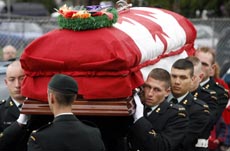Even though prospect of Western intervention in Syria has faded in recent weeks, the crisis nevertheless brought to light important questions about the capabilities of the Canadian Forces (CF). On August 28, Canada’s Foreign Minister John Baird stated that the CF would not likely participate in strikes against Syria. He explained that the planned strikes involved the use of cruise missiles and armed drones: two weapon systems that Canada lacks.
[captionpix align=”center” theme=”elegant” width=”300″ imgsrc=”http://fc09.deviantart.net/fs70/i/2012/201/d/9/tomahawk_cruise_missile_and_launcher_by_uka70-d57yguj.jpg” captiontext=”Tomahawk Missiles About to be Launched”]
Cruise missiles and drones are very different weapon systems, but they are both unmanned. This was important in the Syrian context due to Syria’s integrated air defense system and public unwillingness in Western countries to sustain casualties in a strike on Syria. Cruise missiles are also particularly useful for standoff strikes, and were used successfully by the US and the United Kingdom in 2011 to take down Libya’s air defense system.
Given the benefits of cruise missiles and drones in situations like Syria, why does the Canadian Forces not possess them? After all, Canada has enjoyed the technical capacity to acquire the cruise missiles for a long time and already operates surveillance drones.
For cruise missiles, the reasons are several. First, they are expensive. A Tomahawk missile, which is the main cruise missile operated by the US, costs $1 million each. This is much more expensive than a guided bomb of equivalent payload. Also, owing to Canada’s limited military capabilities, it is clear that the CF would only participate in major foreign operations as part of a coalition. Thus, Canada can usually rely on its NATO allies to provide high-end capabilities like cruise missiles. In Libya, for instance, US cruise missile strikes destroyed the Libyan air defense system, paving the way for Canadian and Allied fighter aircraft to launch airstrikes. Moreover, Canada has always been reluctant to invest in deep strike weapons like cruise missiles because they offend strong Canadian values such as antimilitarism. For instance most Canadians opposed the decision to allow the US to test its Tomahawk missiles in northern Canada starting in the 1980s.
[captionpix align=”center” theme=”elegant” width=”300″ imgsrc=”http://3.bp.blogspot.com/_5ULlIP5MJMs/SyDJ-hiyHoI/AAAAAAAACmI/yPXGx0oNVC0/s320/Baird9.jpg” captiontext=”Minister of Foreign Affairs John Baird”]
The question of weaponized drones is much more complex. While Baird was correct to state that Canada does not currently possess weaponized Unmanned Aerial Vehicles (UAVs), this may soon change. The Department of National Defense (DND) launched the Joint Uninhabited Surveillance and Target Acquisition System (JUSTAS) Project to acquire UAVs in 2000, and the Canadian Forces in Afghanistan have operated unarmed surveillance UAVs since 2009. DND started a program to buy armed drones in 2008. Though this program was temporarily shelved due to lack of funds, it has since been revived and currently the Canadian Forces are set to acquire armed UAVs in a $1 billion program. This has, in turn, led to public debate in Canada about weaponized UAVs.
The military argues that the CF needs weaponized UAVs for complex expeditionary missions like Afghanistan. In testimony to the Senate Defense Committee in 2012, Lt.-Gen. Andre Deschamps of the Royal Canadian Air Force (RCAF) explained that UAVs are needed for both surveillance and ground strike missions. Indeed, Medium Altitude Long Endurance UAVs do present advantages over conventional fighter aircraft for ground strike missions. Because they can loiter at lower altitudes, these UAVs’ sensors have greater resolution and they can respond quickly to changing situations on the ground. Furthermore, they are remote-controlled by human pilots, ensuring that there is a man-in-the-loop for all decisions.
Nevertheless, there are many serious arguments against the use of drones. First, as Stephen Staples, the President of the Rideau Institute, pointed out, repeated drone strikes could easily turn a local population against the CF. Indeed, much of the animosity towards the US in Pakistan and Afghanistan today is a product of repeated US drone strikes. The CF must also contend with Canadian public opinion, since US drone strikes that have caused civilian casualties are very unpopular. Furthermore, the CF can usually rely on its allies to provide weaponized UAV capability. After all, by the RCAF’s own admission weaponized UAVs would only be needed for expeditionary missions, and it is inconceivable that Canada would participate in such a mission without its major power allies. Clearly, there is a need for more public debate on the wisdom of Canada acquiring weaponized UAVs.




